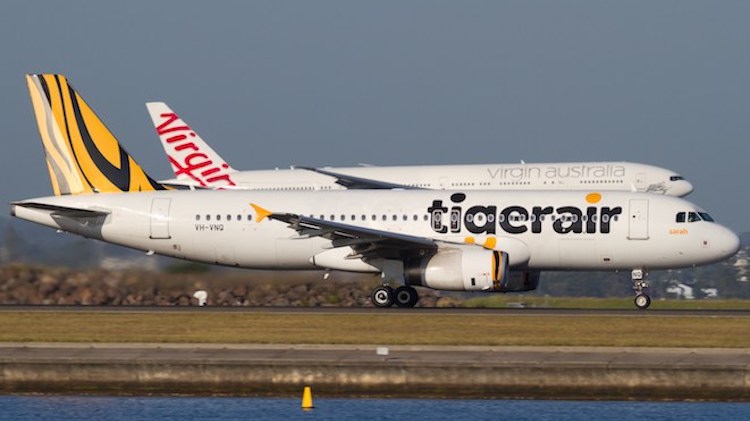Virgin Australia says it expects its underlying profit before tax to grow in excess of 20 per cent for the first half of the current financial year despite a near $90 million increase in fuel costs.
“The group expects that the underlying profit before tax result for the first half of the 2019 financial year will be at least $100 million,” Virgin Australia said in a trading update to the Australian Securities Exchange (ASX) on Monday.
“The expected result for the first half of the 2019 financial year is inclusive of an estimated year-on-year fuel price increase (net of FX and hedging) of $88 million.”
This represents “at least a 22 per cent increase on the prior corresponding period result of $81.9 million”, Virgin said.
The $81.9 million result differs from the reported $102.5 million underlying profit before tax for the first half of 2017/18 due to some changes in the way the company has decided to recognise cash flow hedges.
(Underlying profit before tax removes one-off items to provide a clearer indication of financial performance.)
Further, the Virgin Australia trading update said revenue grew by 9.7 per cent in the three months to September 30, above the seven per cent growth that was forecast in August.
For the current quarter, the airline group said it “anticipates that revenue will grow 10 per cent compared to the prior corresponding quarter, based on current booking trends, particularly in the domestic business”.
The International Air Transport Association (IATA) jet fuel monitor shows the jet fuel price was at US$95.73 per barrel in mid-October, up about 40 per cent from a year earlier. Fuel is typically an airline’s second-biggest cost after staff.
In August, Virgin Australia said it expects the airline’s total fuel bill to be $1.2 billion for 2018/19, up about 22 per cent from $986 million in the prior year.

Airline profitability to be dented by rising fuel prices
IATA said in June airlines around the world were expected to collectively post a US$33.8 billion profit in calendar 2018, down from the US$38 billion in profits earned in the prior year.
While airlines in the Asia Pacific region, and indeed globally, are still forecast to post healthy profits for the period ahead, the extremely competitive environment makes increasing ticket prices to recover the rising fuel cost difficult, according to Association of Asia Pacific Airlines (AAPA) director general Andrew Herdman.
“The pressure in Asia based on the results we’ve seen so far this year are that it’s been very difficult to pass on the full cost impact and so we are seeing margins come down and profitability pull back as a result,” Herdman said at the recently concluded assembly of presidents in Jeju, South Korea on October 18.
“Overall, I still expect Asian airlines in aggregate to make substantial profits but it seems pretty clear that it will be lower than the levels we’ve seen in previous years.”
At Virgin Australia’s 2017/18 full-year results presentation in August, chief executive John Borghetti was asked if ticket prices might have to rise due to higher oil prices.
In response, Borghetti said Virgin Australia, like any business, had to manage when costs went up.
“You can manage some of that through obviously cost reduction in other areas,” Borghetti said.
“But you never say you don’t translate some of those costs into pricing, at some point you have to so we will just monitor it very carefully.
“But very importantly, the overriding factor here is you’ve got to remain competitive. I think the market is very competitive still.”
A measure of domestic ticket prices from the Bureau of Infrastructure, Transport and Regional Economics (BITRE) shows best discount and restricted economy fares are up nine per cent and 21 per cent, respectively in October compared with a year ago.
However, business class fares are down about one per cent in October.
The BITRE airfare series is a price index of the lowest available fare in each fare class, weighted over selected routes.
Both Virgin Australia and Qantas have kept a tight rein on capacity in recent times in an effort to improve yields and better match the number of seats in the market with demand.
BITRE figures show capacity in the Australian domestic market, measured by available seat kilometres (ASK), decreased by 0.2 per cent in the 12 months to June 30, compared with the prior year, while demand measured by revenue passenger kilometres (RPK) rose two per cent.
As a consequence, load factors rose 1.7 percentage points to 80.1 per cent.
Also, the total number of aircraft trips decreased by 0.9 per cent.
“Load factors on individual routes increased on 50 of the 64 RPT routes for which data is available in both years,” the BITRE report said.
While Virgin Australia did not offer earnings guidance for the second half of 2018/19, Monday’s trading update notes the second half of the year was traditionally a weaker period for the aviation industry.
“The group will continue to monitor current trends and will update the market if required,” Virgin Australia said.










